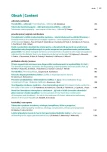The benefit of magnetic resonance for diagnosing cardiomyopathy and myocarditis
Authors:
Michal Fikrle 1,2; Petr Kuchynka 2; Martin Mašek 3; Jana Podzimková 2; Jan Kuchař 2; Aleš Linhart 2; Tomáš; Paleček 2
Published in:
Vnitř Lék 2016; 62(12): 976-984
Category:
Reviews
První část článku byla uveřejněna ve Vnitř Lék 2016; 62(10): 795–803.
Overview
Magnetic resonance is becoming an increasingly used examination in cardiology, since it greatly improves the accuracy of diagnosing of many heart diseases. At present magnetic resonance is the gold standard in assessing the volumes of the heart chambers and the systolic function of both ventricles. The possibility of detecting tissue characteristics to refine the diagnostics of different types of myocardial pathology is of essential importance. The authors summarize in the article the present knowledge about the use of magnetic resonance of the heart in the field of myocardial disease, i.e. cardiomyopathy and myocarditis. In the first of this article, a general overview of cardiac magnetic resonance examination has been given, followed by detailed description of its usefulness in dilated cardiomyopathy and myocarditis, in hypertrophic cardiomyopathy and arrhythmogenic right ventricular cardiomyopathy. The second part of the review summarizes the benefits of cardiac magnetic resonance examination in cardiac amyloidosis and other less common cardiomyopathies.
Key words:
fibrosis – cardiomyopathy – magnetic resonance – myocarditis – late contrast agent saturation
Sources
Seznam literatury obsahuje pouze výběr recentních literárních odkazů. Úplný seznam litertury naleznete na www.vnitrnilekarstvi.eu
90. Arbustini E, Weidemann F, Hall JL. Left Ventricular Noncompaction A Distinct Cardiomyopathy or a Trait Shared by Different Cardiac Diseases? J Am Coll Cardiol 2014; 64(17): 1840–1850.
95. Jenni R, Oechslin E, Schneider J et al. Echocardiographic and pathoanatomical characteristics of isolated left ventricular non-compaction: a step towards classification as a distinct cardiomyopathy. Heart 2001; 86(6): 666–671.
96. Petersen SE, Selvanayagam JB, Wiesmann F et al. Left ventricular non-compaction: insights from cardiovascular magnetic resonance imaging. J Am Coll Cardiol 2005; 46(1): 101–105.
97. Jacquier A, Thuny F, Jop B et al. Measurement of trabeculated left ventricular mass using cardiac magnetic resonance imaging in the diagnosis of left ventricular non-compaction. Eur Heart J 2010; 31(9): 1098–1104.
98. Captur G, Muthurangu V, Cook C et al. Quantification of left ventricular trabeculae using fractal analysis. J Cardiovasc Magn Reson 2013; 15 : 36. Dostupné z DOI: <http://dx.doi.org/10.1186/1532–429X-15–36>.
99. Dawson DK, McLernon DJ, Raj VJ et al. Cardiovascular Magnetic Resonance Determinants of Left Ventricular Noncompaction. Am J Cardiol 2014; 114(3): 456–462.
101. Dubrey SW, Hawkins PN, Falk RH. Amyloid diseases of the heart: assessment, diagnosis, and referral. Heart 2011; 97(1): 75–84.
111. Fikrle M, Palecek T, Masek M et al. The diagnostic performance of cardiac magnetic resonance in detection of myocardial involvement in AL amyloidosis. Clin Physiol Funct Imaging 2016; 36(3): 218–224.
117. Karamitsos TD, Piechnik SK, Banypersad SM et al. Noncontrast T1 Mapping for the Diagnosis of Cardiac Amyloidosis. JACC Cardiovasc Imaging 2013; 6(4): 488–497.
124. Dubrey SW, Falk RH. Diagnosis and Management of Cardiac Sarcoidosis. Prog Cardiovasc Dis 2010; 52(4): 336–346.
139. Smedema JP, Snoep G, van Kroonenburgh MP et al. Evaluation of the accuracy of gadolinium-enhanced cardiovascular magnetic resonance in the diagnosis of cardiac sarcoidosis. J Am Coll Cardiol 2005; 45(10): 1683–1690.
143. Salemi VM, Rochitte CE, Shiozaki AA et al. Late gadolinium enhancement magnetic resonance imaging in the diagnosis and prognosis of endomyocardial fibrosis patients. Circ Cardiovasc Imaging 2011; 4(3): 304–311.
144. Moon JC, Sachdev B, Elkington AG et al. Gadolinium enhanced cardiovascular magnetic resonance in Anderson-Fabry disease. Evidence for a disease specific abnormality of the myocardial interstitium. Eur Heart J 2003; 24(23): 2151–2155.
147. Imbriaco M, Spinelli L, Cuocolo A. MRI characterization of myocardial tissue in patients with Fabry’s disease. Am J Roentgenol 2007; 188(3): 850–853.
148. Pica S, Sado DM, Maestrini V et al. Reproducibility of native myocardial T1 mapping in the assessment of Fabry disease and its role in early detection of cardiac involvement by cardiovascular magnetic resonance. J Cardiovasc Magn Reson 2014; 16 : 99. Dostupné z DOI: <http://dx.doi.org/10.1186/s12968–014–0099–4>.
150. Boucek D, Jirikowic K, Taylor M. Natural history of Danon disease. Genet Med 2011; 13(6): 563–568.
151. Majer F, Pelak O, Kalina T et al. Mosaic tissue distribution of the tandem duplication of LAMP2 exons 4 and 5 demonstrates the limits of Danon disease cellular and molecular diagnostics. J Inherit Metab Dis 2014; 37(1): 117–124.
160. Verhaert D, Richards K, Rafael-Fortney JA et al. Cardiac Involvement in Patients with Muscular Dystrophies, Magnetic Resonance Imaging Phenotype and Genotypic Considerations. Circ Cardiovasc Imaging 2011; 4(1): 67–76.
167. Anderson LJ, Holden S, Davis B et al. Cardiovascular T2-star (T2*) magnetic resonance for the early diagnosis of myocardial iron overload. Eur Heart J 2001; 22(23): 2171–2179.
170. Kirk P, Roughton M, Porter JB et al. Cardiac T2* magnetic resonance for prediction of cardiac complications in thalassemia major. Circulation 2009; 120(20): 1961–1968.
172. Abdel-Aty H, Cocker M, Friedrich MG. Myocardial edema is a feature of Tako-Tsubo cardiomyopathy and is related to the severity of systolic dysfunction: insights from T2-weighted cardiovascular magnetic resonance. Int J Cardiol 2009; 132(2): 291–293.
173. Deetjen AG, Conradi G, Mollmann S et al. Value of gadolinium-enhanced magnetic resonance imaging in patients with Tako-Tsubo-like left ventricular dysfunction. J Cardiovasc Magn Reson 2006; 8(2): 367–372.
178. Sliwa K, Hilfiker-Kleiner D, Petrie MC et al. Current state of knowledge on aetiology, diagnosis, management, and therapy of peripartum cardiomyopathy: a position statement from the Heart Failure Association of the European Society of Cardiology Working Group on peripartum cardiomyopathy. Eur J Heart Failure 2010; 12(8): 767–778.
181. Mouquet F, Lions C, de Groote P et al. Characterisation of peripartum cardiomyopathy by cardiac magnetic resonance imaging. Eur Radiol 2008; 18(12): 2765–2769.
Labels
Diabetology Endocrinology Internal medicineArticle was published in
Internal Medicine

2016 Issue 12
Most read in this issue
- Thrombophilia
- Coffee as hepatoprotective factor
- Oral antidiabetic drugs in treatment of type 1 diabetes mellitus
- Takotsubo cardiomyopathy: incidence, etiology, complications, therapy and prognosis
